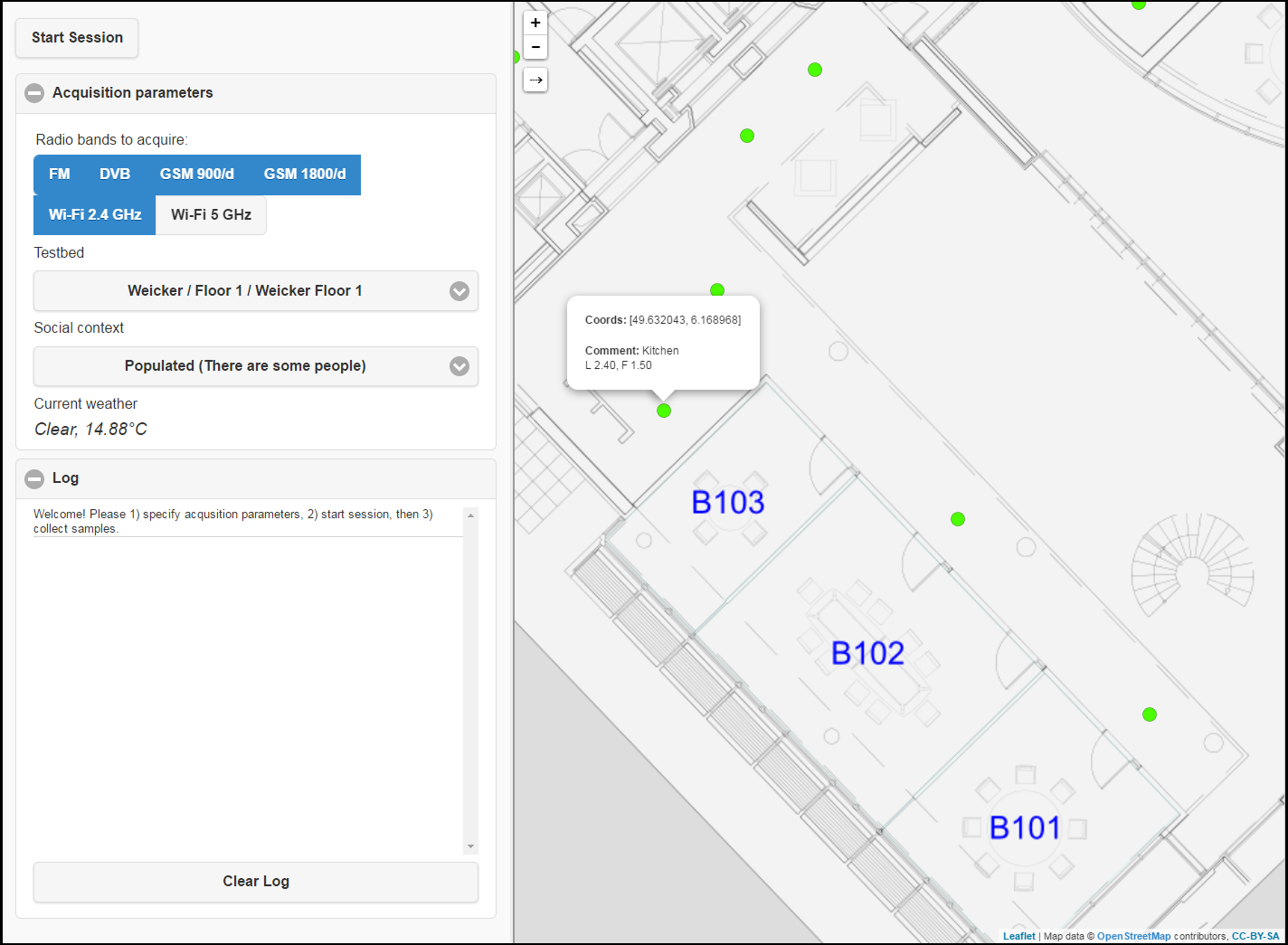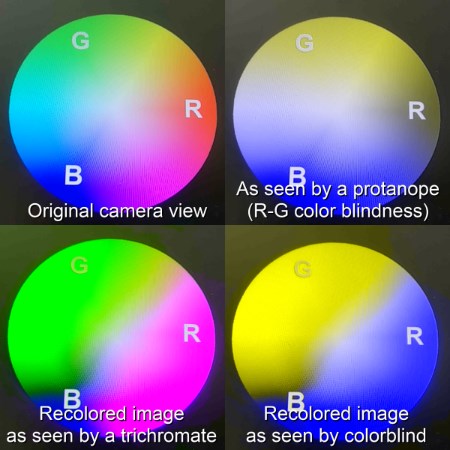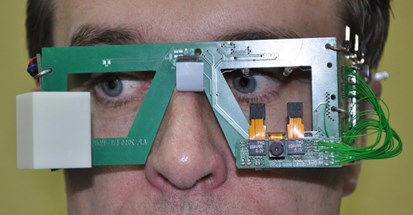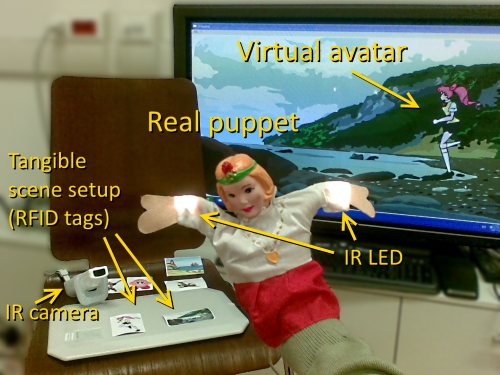Research Projects
-
INDOORS: Indoor navigation with ambient radio signals (funded by the National Research Fund of Luxembourg). I am the principal investigator of the project.

- Small-scale 3D controller using a wearable magnet.
In this project, I experimented with touch-free 3D interaction. The prototype was based on four digital compasses connected to a Raspberry PI, and some basic physics to estimate the location of a magnetic ring.
- Colorizer: Smart glasses aid for the colorblind — my personal project, contributed to the eGlasses.

Colorizer is smart glasses application for helping colorblind people to distinguish problematic colors in daily life. The prototype processes a live video stream from the mobile camera, converts colors according to the user needs, and displays the augmented result. Color transformation ensures high contrast between colors which are otherwise indistinguishable for the user.
The prototype is available for Android smartphones and Epson BT-200 glasses; the app has received an award in the Espon Russia app contest.
- eGlasses: The interactive eyeglass for mobile, perceptual computing (CHIST-ERA funding)

First prototype of eGlasses The eGlasses project focused on the development of an open platform in the form of multisensory electronic glasses and on the integration and designing of new intelligent interaction methods using the eGlasses platform. This is an initial development focused on long-term research and technological innovation in perceptual and super-perceptual (e.g. heart rate, temperature) computing.
- Magnetic joystick for mobile games — MSc project of Saeed Afshari. University of Luxembourg, 2014. I was a co-advisor.
We introduce and explore usability and performance aspects of a novel compass-based control for tangible around-device interaction, and compare it with traditional mobile gaming controls, such as touchscreen thumbstick, swiping and tilt-based approaches.
Playing games with a whiteboard wiper. - LiveCity: Live Video-to-Video Supporting Interactive City Infrastructure (EC FP7 funding)
- Interstress: an ICT-based solution for the assessment and treatment of psychological stress (EC FP7 funding)
In this project, I worked on design, implementation and integration of the mobile platform for psychological stress detection, monitoring and treatment. An Android application captured patients' behaviour using multiple sensing modalities (motion activity level, heart- and breath-rate sensor, location, self-assessment questionnaires). When the system recognized stressful events in the sensory data stream, the app offered a selection of interactive game-like relaxation exercizes to alleviate the stress.
- Indoor positioning using FM radio signals. Ph.D. thesis. University of Trento, 2011
(short summary, slides,
full pdf).
My PhD project was the first work to investigate the feasibility of indoor positioning using FM radio signals (in particular, those generated by the ambient FM stations). The experimental results demonstrate that indoor FM positioning can provide an accuracy comparable to Wi-Fi, with 2 to 5 times longer battery life, while commercial FM stations ensure a worldwide coverage.
This project continued after the graduation, and the most recent findings can be found in the PerCom-2012 paper.
- iTheater: Tangible interactions for storytelling. Create-Net, 2008.

iTheater demo iTheater was a preliminary work on an interactive integrated system for tangible storytelling, dedicated to young children. Based on the analogy with hand puppets’ theatre, the system aimed to create an interactive environment where children could give life to their imaginary characters by creating, editing and recording computer animations in a simple and exciting way, through the movement and tactile manipulation of traditional hand puppets.
- Magic Wand: Smart home control using WiiMote gesture recognition.
Undergraduate thesis of Valentina Pasqualino. Create-Net, 2008. I was a co-advisor of the thesis.
The aim of the project was to enable the user to control domestic appliances by drawing gestures in the air. Less formally, the user could pretend to be a magician and to control the lights or blinds by simply waving a "magic wand". The tip of the wand had an infrared LED, which was tracked by a fixed WiiMote camera. The acquired coordinates of the infrared light source were then sent to a PC via Bluetooth. Finally, the computer performed gesture recognition and controlled a set of power-line relay switches.
- GeoMedia: Location-based multimedia messaging. Create-Net, 2007.
Unlike paper-based Post-Its, virtual notes preserve privacy, can be remotely put to any place and do not clutter the environment. In contrast with other location-based messaging systems working with plain text notes, GeoMedia supports rich multimedia content such as high-resolution images, audio and video.
- Supporting PCR–related activity with Implicit Culture. MSc final project. University of Trento, 2006 (pdf).
In this work, we performed an analysis of the PCR-related activities in a biological laboratory and identified the information needs of the biologists performing PCR. Also, we have elaborated a set of requirements to a system for PCR support and described an architecture of such system using Implicit Culture concepts. Finally, we have developed a prototype of the system, and evaluated it with experts. This work has been the result of close collaboration with biologists, individual interviews and on-site observations in laboratory.
- Development of web-based system for support of distant learning in special courses. BSc final project. BSU, 2004 (pdf [in Russian], summary [in English]).
As a result of this work, a web system for distant learning has been designed and implemented. A traditional course on neural networks has been adapted to be used in a distant way and enhanced with interactive content. The system has been adapted in the studying process at the Systems Analysis department of BSU.
- Development of parallel algorithms for neural network training. BSU, 2004.
This project has been dedicated to the development of the algorithms for fast training of artificial neural networks, utilizing the benefits of parallel computing.
- Methods of neural network simulation of physical processes in stochastic systems. BSU, 2003
(pdf [in Russian]).
In this work I have applied neural networks to the modelling of stochastic processes in physical devices. I tested a multi-layer perceptron and a stochastic network (Bolzman machine) and demonstrated the suitability of the latter to this task.
- Modelling of stochastic neural network. 4th year project. BSU, 2003
(pdf [in Russian]).
In this work I used neural networks for modelling of stochastic processes in physical devices. I have used MLPs and Bolzman machine and demonstrated the suitability of the latter for the task.
- Methods of simulation, analysis and data processing in systems with distributed resources. BSU, 2002
(pdf [in Russian]).
In this project I developed a distributed system for parallel simulation modelling (nicknamed "ParSim"). It implemented two approaches that address high resource requirements, namely, neural network approximation and parallelization of calculations. My colleague then successfully applied this system for the analysis of photo-physical processes in complex bio-molecular systems.
- Data compression algorithms. 3rd year project. BSU, 2002
(pdf [in Russian]).
In this work I reviewed classical data compression algorithms (RLE, LZW, Huffman, arithmetic) and existing methods for search in the compressed data. Here I also proposed an algorithm for recognition of Huffman-compressed emission spectra directly without decompression, which improved the speed of processing.